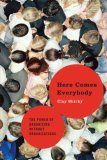“webibliography” links for ‘Here Comes Everybody’ by Clay Shirky (part 1)
April 30, 2008
I recently read Here Comes Everybody by Clay Shirky and thought instead of a review it might be more useful to post the links from the bibliography (first two chapters in this part) plus a few links related to the book in general. [5/13 – link to the complete “webibliography”]
Here Comes Everybody Blog – with this transcript of Shirky’s speech on “cognitive surplus” at the Web 2.0 Expo
Videos
Clay Shirky’s Harvard talk linked at boingboing
Authors@Google: Clay Shirky video
bibliography & links p. 309-319
Ch. 1: It Takes a Village to Find a Phone
p. 1: Ivanna’s phone http://evanwashere.com/StolenSidekick
“stolen sidekick” google search
p.7 We the Media: Grassroots Journalism By the People, For the People by Dan Gillmor (O’Reilly Media, 2004)
Center for Citizen Media www.citmedia.org
p. 17: an architecture of participation
www.oreillynet.com/pub/a/oreilly/tim/articles/architecture_of_participation.html
p.18 a plausible promise Eric Raymond, “The Cathedral and the Bazaar”
p. 22 Within the Context of No Context, George W.S. Trow (Atlantic Monthly Press, 1997)
Ch. 2: Sharing Anchors Community
p. 25: Birthday Paradox at Wikipedia
p. 28 “More is Different” by Philip Anderson Science 177 (4047) Aug. 4, 1972, pp. 393-96.
p. 29 The Mythical Man-Month: Essays on Software Engineering by Frederick P. Brooks, Jr. (Addison Wesley, 1975)
p. 30 “The Nature of the Firm” by R.H. Coase, Economica, 4(16), Nov. 1937, p. 386-405
p. 31 Leading Teams: Setting the Stage for Great Performances by J. Richard Hackman (Harvard Business School Press, 2002)
p. 31 The Mermaid Parade (at Flickr)
p. 33 tagging “Ontology is Overrated”
p. 40 The Visible Hand: The Managerial Revolution in American Business by Alfred D. Chandler, Jr. (Harvard University Press, 1977) (pbk new ed. 1993)
p. 47 cooperation
The Origin of Wealth: Evolution, Complexity, and the Radical Remaking of Economics by Eric D. Beinhocker (Harvard Business School Press, 2006)
Small Groups as Complex Systems: Formation, Coordination, Development, and Adaptation by Holly Arrow, Joseph E. McGrath, and Jennifer L. Berdahl (Sage, 2000)
Why Humans Cooperate: A Cultural and Evolutionary Explanation by Natalie Henrich and Joseph Henrich (Oxford University Press, 2007)
p. 51 “The Tragedy of the Commons” by Garrett Hardin, Science 162 (3859) Dec. 13, 1968, pp. 682-83).
The Logic of Collective Action Public Goods and the Theory of Groups by Mancur Olson (Harvard University Press, 1965) (rev. ed., 1971)
p. 54 ridiculously easy group-forming – Seb Paquet, “Making Group-Forming Ridiculously Easy”
David Reed, “That Sneaky Exponential”


 The current issue of New Scientist has a feature on
The current issue of New Scientist has a feature on 


